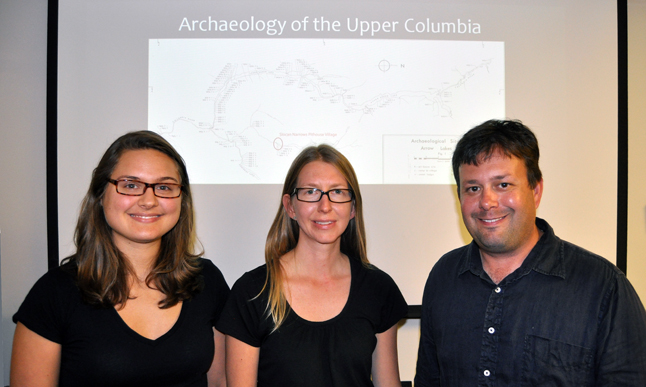
By David F. Rooney
American archeologists peeling back the layers at a 3,000-year-old Sinixt village site at Lemon Creek unveiled some of their findings during a presentation at the Revelstoke Museum & Archives on Monday.
After a welcome by Michelle Cole on behalf of the Sinixt people, Hamilton College Archaeologist and Assistant Professor Nathan Goodale talked about the Slocan Narrows Archaeology Project, which is an ongoing summer field school for 11 post-secondary students sponsored by Hamilton College of Clinton, NY, Selkirk College and Western Connecticut College.
Between 80 and 90 per cent of the village of circular pit houses has been eroded away since the 1960s as the Slocan River carvd new channels, but what has so far been excavated shows the site has a history of occupation by native Americans going back more than 3,000 years.
“This is probably one of the last big villages remaining in the Columbia Basin,” Goodale told an audience of about 40 people on Monday evening.
Much of the information he and fellow presenters Alissa Nauman and Erica Kowsz provided was relatively new to many local residents.
“When I was growing up we often thought there wasn’t much First Nations history in Revelstoke,” said Laura Stovel.
The Shuswap, Okanagan and Ktunaxa peoples all claimed this as traditional-use areas. And there is at least one known Sinixt campsite within city boundaries. The Sinixt people were often identified as the Lakes People and used the rivers and lakes of the Columbia Basin from the northwestern US up to about Mica. Although the Sinixt are recognized as status Indians in the US and have a reserve at Colville, Washington, they were declared officially extinct by the Canadian government in 1956. Click here to learn more about that grievance.
Surveys by archaeologists and anthropologists over the last 50 years have built up a picture of fairly intensive seasonal use in the Revelstoke area. Campsites have been identified at Arrowhead, where there was also a known rock art site, and Beaton. However, both the Beaton and Arrowhead sites were drowned as the Columbia was dammed in Canada. Grease trails have also been identified in the Eagle Pass and up the Monashees to Sugar Lake among other places in our region. Grease trails were developed for trade between indigenous people, particularly the trade in eulachon oil (also known as oolichan oil. The grease from these small fish could be traded for furs, copper and obsidian — among other things. The Stó:lō people of the Fraser River simply ate the fish, either fresh or smoked, but the people of the Interior used the oil as a condiment and in various other ways.

The Lemon Creek village site’s pit houses were periodically burned, deliberately, and then rebuilt. Some of the houses were very large and capable of housing 75 people each and all were very, very clean. The inhabitants killed, processed and ate a wide variety of animals ranging from fish, shellfish and rodents to birds and larger animals. However, identifying all of the prey is difficult because bone fragments were tossed in the central hearths of each house. They also consumed a wide variety of nuts and berries. In total the field school as found 13,000 bone fragments, including 10,709 calcinized pieces from medium-to-large mammals.
They have also found stone tools and projectile points, but few organic remains such as basketry or processed hide because of the acidity of the soil.
The pit houses appear to have been occupied for 20-40 years before they were abandoned and intentionally burned. That cycle of abandonment, burning and then rebuilding and re-occupation continued over 3,000 until the 1770s when a smallpox epidemic burned through BC’s native population, Goodale said.
The team also presented a video, entitled A Journey Upstream: The Past and Presence of an “Extinct” People, by student Erica Kowsz.
The Museum has two copies of the video that are on reserve for educational use.
The presentation was very well received and there were a lot of questions about the field school’s work.
Click here to find out more about the project.
Click here to find out more about the Sinixt people at Wikipedia.
Click here and here to learn more about the Sinixt people at their own websites.
The Revelstoke Current has previously published two stories about the project. Click here to read one by Laura Stovel. Click here to read one by Leslie Savage.



